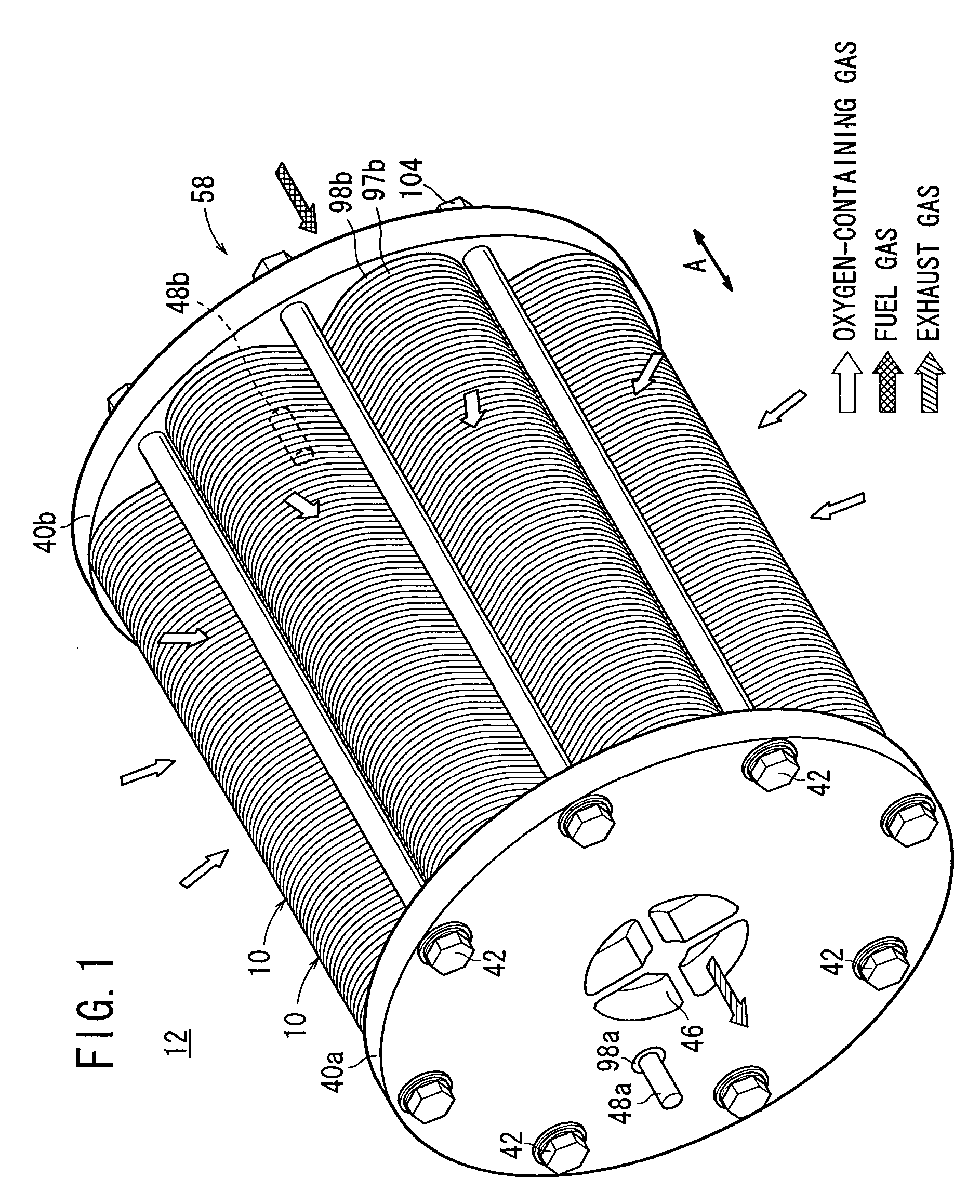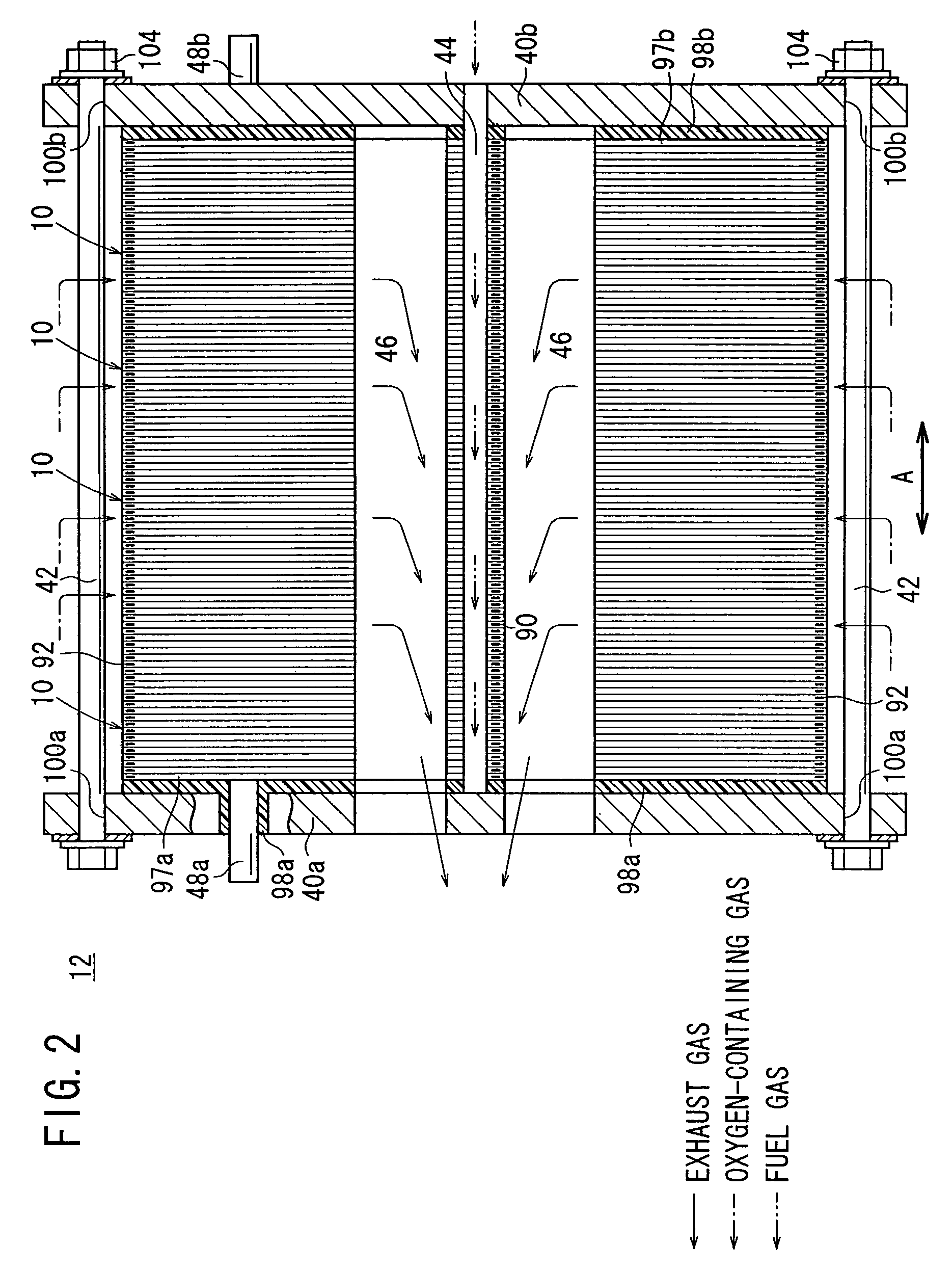Fuel cell
a fuel cell and cell technology, applied in the field of fuel cells, can solve the problems of low rigidity of separators, difficult to produce a large electricity, and the electrical membrane of stabilized zirconia cannot be very thin for maintaining sufficient mechanical strength, and achieve the effect of simple structur
- Summary
- Abstract
- Description
- Claims
- Application Information
AI Technical Summary
Benefits of technology
Problems solved by technology
Method used
Image
Examples
first embodiment
[0040]FIG. 1 is a perspective view schematically showing a fuel cell stack 12 formed by stacking a plurality of fuel cells 10 according to the present invention, and FIG. 2 is a cross sectional view showing a part of the fuel cell stack 12.
[0041]The fuel cell 10 is a solid oxide fuel cell (SOFC) for stationary and mobile applications. For example, the fuel cell 10 is mounted on vehicles. In an example of the first embodiment shown in FIG. 3, the fuel cell stack 12 is used in a gas turbine 14. In FIG. 3, the shape of the fuel cell stack 12 is different from those shown in FIGS. 1 and 2, however, the structure is substantially the same.
[0042]The fuel cell stack 12 is disposed in a casing 16 of the gas turbine 14. A combustor 18 is disposed at the center of the fuel cell stack 12. The fuel cell stack 12 discharges an exhaust gas as a mixed gas of a fuel gas and an oxygen-containing gas after reaction into a chamber 20 toward the combustor 18. The chamber 20 is narrowed in a flow direct...
third embodiment
[0099]FIG. 15 is a cross sectional view schematically showing a gas turbine 130 including relatively large fuel cell stacks 12b according the present invention, and FIG. 16 is a front view showing the gas turbine 130.
[0100]In the gas turbine 130, four fuel cell stacks 12b are arranged along a first circle in the casing 132 at intervals of 90° and four fuel cell stacks 12b are arranged along a second circle in the casing 132 at intervals of 90°. The first circle is spaced from the second circle at a predetermined distance in an axial direction of the casing 132 indicated by an arrow X. Orientation of the four fuel cell stacks 12b arranged along the first circle is shifted by 45° from the second fuel cell stacks 12b arranged along the second circle. Therefore, the fuel cell stacks 12b do not contact with each other. Each of the fuel cell stacks 12b is covered by a cover 134, and a hot air supply passage 136 is formed inside the cover 134.
[0101]In the gas turbine 130, the four fuel cel...
PUM
| Property | Measurement | Unit |
|---|---|---|
| temperature | aaaaa | aaaaa |
| temperature | aaaaa | aaaaa |
| ion-conductive | aaaaa | aaaaa |
Abstract
Description
Claims
Application Information
 Login to View More
Login to View More - R&D Engineer
- R&D Manager
- IP Professional
- Industry Leading Data Capabilities
- Powerful AI technology
- Patent DNA Extraction
Browse by: Latest US Patents, China's latest patents, Technical Efficacy Thesaurus, Application Domain, Technology Topic, Popular Technical Reports.
© 2024 PatSnap. All rights reserved.Legal|Privacy policy|Modern Slavery Act Transparency Statement|Sitemap|About US| Contact US: help@patsnap.com










